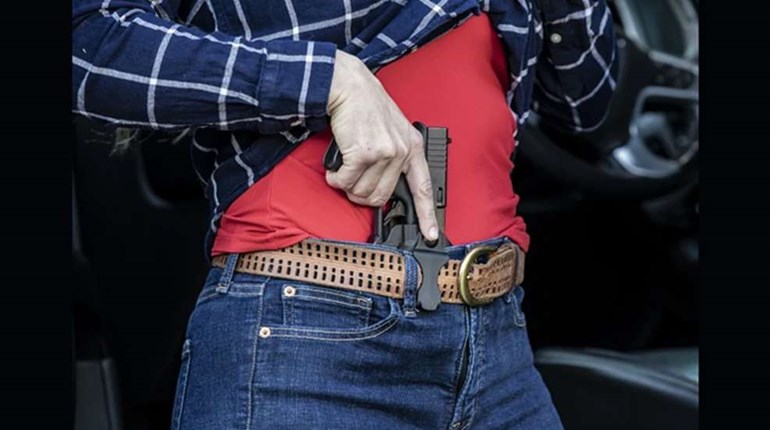
Undoubtedly, Glock was late to the party with a micro-size .380 ACP handgun. By the time Ruger introduced its LCP in 2008, the race to produce miniature .380 ACP pistols was well underway. Similar offerings appeared from most of the major manufacturers, and the "9 mm Kurz" was the hot pistol caliber for several years. Although Glock had models in most every popular semi-automatic chambering, a .380 ACP was noticeably absent from its lineup—at least in the United States. Glock actually has a double-stack .380 ACP available in overseas markets: the G25. U.S. law, however, prohibits domestic sale of the G25 due to import restrictions.
The company finally overcame the legal hurdles by manufacturing the pistol at Glock's domestic facility in Smyrna, GA. While this smallest Glock may have been designedin Austria, it is made right here in the U.S.
Small, Yet Familiar
The G42 is unmistakably a Glock, simply smaller than we have ever seen before. Previously, the G26 and G27 were referred to as "baby" Glocks, but both are relatively thick, double-stack variants that are larger in every dimension than the G42. Neither would be considered a pocket or deep-concealment model. Slightly larger than most micro-size .380 ACP pistols, the G42 is still pocketable at roughly 6 inches long, 4 inches high and an inch wide. Weight, however, is very important for a pocket pistol, and the G42 tips the scale at less than 15 ounces, fully loaded.
In addition to resembling a smaller version of every extant Glock, the G42 maintains the same basic controls. Glock's "safe-action" firing system requires no traditional thumb safety. The only external safety is the trigger safety, a lever incorporated into the trigger itself that must be fully depressed during the trigger pull for the handgun to fire. Other external controls are the slide-stop lever and the magazine catch. These parts are identical in size to those of the larger Glocks.
Glocks were the first semi-autos to truly popularize a striker-fired mechanism. Like other pistols in the company's line, the G42's striker is partially tensioned by operation of the slide. As such, the trigger can be quite light; it requires approximately 5 pounds of pressure with a long trigger pull. Although Glocks are often characterized as "double-action-only" pistols, that term is not technically correct—the safe action works much like a double-action pistol but, without a hammer to move, the action is not, shall we say, "double" on a striker-fired handgun.

Anyone familiar with Glock triggers will feel right at home with the G42. The trigger and trigger guard are actually the same size and shape as other Glocks, and the trigger pull feels the same—light initial take-up, followed by a crisp break. In the world of pocket-size pistols, a trigger this good is not common. Some shooters find Glock triggers to be mushy—I have found them to be an acquired taste—and one can learn to love them.
As with all Glocks, the G42's frame is constructed from a proprietary polymer—the exact composition is a secret. We do know Glock frames are strong, light and extremely durable, based on nearly three decades of positive feedback from the field. The frames actually flex a bit when fired, which helps dampen felt recoil and could be quite beneficial on such a small pistol. The slide is made from hardened steel with a matte-black finish. Where Tenifer was traditionally the coating used on Glocks, the company no longer specifies what coating process it uses on the slides of its Gen4 handguns (of which the G42 is part). To my knowledge, the new process has not garnered any significant complaints, so it is likely as durable and corrosion-resistant as the old.
Factory sights on the G42 are not the usual "nubs" found on pocket guns, but actual fixed sights offering a full-size sight picture. The rear sight has the familiar U-shaped white outline associated with Glocks, and the front sight sports a single white dot. This system provides a quick sight picture for fast shooting. If you are not a fan of Glock's factory sights, they are easy to upgrade. The rear sight is dovetailed, while the front sight is retained by a single nut. An ever-increasing number of aftermarket sights are already available for the new Glock.

The G42's single-stack magazine holds six rounds of .380 ACP. Like all other Glock factory magazines, they have a polymer body with a metal lining. There are witness holes for each round, so capacity can be seen at a glance. As you would expect, they can be easily disassembled for cleaning.
In fact, the entire pistol is easy to disassemble without any tools. As with any Glock, after unloading the pistol and checking both visually and by touch to ensure it is unloaded, the trigger is pulled, then the slide is removed by holding the slide slightly to the rear and pushing down the recessed disassembly nubs. The slide comes forward off the frame, and then the captive double recoil-spring/guide-rod assembly and barrel are easily removed. Sound familiar? That's because it is identical to every other Glock's disassembly procedure.
As a whole, one of the benefits of the Glock system is parts can be easily replaced without any fitting or gunsmithing. For a reasonable fee, anyone can take a Glock armorer's class and learn all the tricks for maintaining the company's entire line of pistols, which might be a good investment, especially if you are a fan of Glocks.
Close to Perfect
Although quite small, the G42 shoots like a much larger pistol. Its size is actually a great compromise between a "too big to conceal" subcompact pistol and a "too small to shoot" micro-size handgun. The G42 is easy to manipulate, because it has a full-size trigger, full-size slide-stop lever and full-size magazine release. There is no need to fiddle with tiny or undersize controls. Even speed loads and malfunction drills are much easier than with most similar offerings in this size category.
At the range, the production-model G42 I tested was impressive. Using three premium brands of ammo, group sizes averaged slightly less than 2 inches at 7 yards—a reasonable distance to test what amounts to a pocket pistol. In fact, after the accuracy testing, the resulting group could be covered with the palm of my hand, which is noteworthy for any self-defense pistol, and very impressive for one this small.
The fixed factory sights are well regulated, and the handgun shoots very close to point-of-aim. At 7 yards, I had no problem making solid hits on pie plates, firing in rapid succession. The combination of good sights and a good trigger make it easy to shoot this pint-size pistol quickly and accurately.
In the course of several hundred rounds of testing, I experienced a handful of failures to feed. Interestingly, malfunctions occurred only with Federal Premium Hydra-Shok JHP rounds. I didn't take these hiccups as an indictment of this particular load—just that it did not get along with this particular pistol. Otherwise, the G42 worked flawlessly with defensive loads from Hornady and Speer, as well as Federal's American Eagle target loads. As always, take the time to verify your chosen ammunition by ensuring it functions properly in your handgun before relying on it for self-defense.

The G42 allows for a wide variety of carry options. For most people, pocket carry is a realistic option, although the G42 is not the most pocketable pistol on the market. I encountered no problems pocket carrying it over an extended period and in multiple types of casual pants. For those who prefer other methods for concealed carry, there are many. Belt carry—whether inside or outside the waistband—is easy with a handgun this size. The G42 will disappear in a tuckable inside-the-waistband holster. For even deeper concealment, the G42 will work well in an ankle holster, in a belly-band or with other below-the-waistband methods of carry. The possibilities for carrying this micro-size Glock are almost unlimited.
Worth the Wait
If you are already a Glock fan, you are unlikely to be disappointed in the G42. It is everything you love in the Glock platform, only smaller. The handgun will immediately feel familiar, and can be carried in ways that larger Glock variants simply cannot. If the G42 is your first Glock pistol, it may win you over to the company's entire line of pistols. Once you learn to love the Glock's trigger and manual of arms, the G42 is a natural complement to the larger Glock models and a multitude of other chamberings.
While the G42 is bigger than many .380 ACP pocket pistols, the additional size pays large dividends. It makes the pistol much easier to handle, easier to shoot and it reduces the felt recoil, which makes this a soft-shooting handgun that should work well for anyone, even the most recoil-sensitive among us.
Almost any time I talk about the G42, however, there is an elephant in the room. In the time it took Glock to produce a pocket-size .380 ACP, most of the major manufacturers moved on to pocket-size 9 mm pistols. Many Glock fans started asking: "When will Glock produce a micro 9 mm?" Of course, I can only speculate, but it seems the company could likely produce a 9 mm in the same frame size as the G42—only time will tell, but the possibility is definitely exciting. In the meantime, it is an excellent pocket pistol that fills a gaping hole in the company's lineup. I expect Glock will sell a ton of these micro-sized pistols to satisfy a pent-up demand.
Although admittedly a bit late to the market, the G42 offers the benefits of the Glock platform in a truly pocket-size pistol for the first time. The new platform has a lot of potential. I hope the G42 is just the beginning of Glock's foray into smaller concealed-carry pistols.
Specifications
Manufacturer: Glock; (770) 432-1202
Action Type: Recoil-operated, semi-automatic
Caliber: .380 ACP
Capacity: 6+1 rounds
Frame Material: Textured polymer
Slide Length: 5 inches
Grips: Molded-in polymer
Barrel Length: 3.25 inches
Rifling: Hexagonal; 1:9.84-inch RH twist
Sights: Fixed; white-outline rear; single-dot front
Trigger Pull Weight: 5 pounds, 8 ounces
Length: 5.94 inches
Width: .94 inch
Height: 4.13 inches
Weight: 13.8 ounces
Accessories: Two six-round magazines, hard plastic case, manual, cleaning brush, lock
MSRP: $480
Shooting Results
| Load | Velocity | Group Size | ||
| Smallest | Largest | Average | ||
| Federal Premium 90-grain Hydra-Shok JHP | 918 | 1.81 | 2.38 | 2.19 |
| Hornady Critical Defense 90-grain XTP | 833 | 1.50 | 2.13 | 1.85 |
| Speer Gold Dot 90-grain GDHP | 936 | 1.44 | 2.25 | 1.86 |
Velocity measured 10 feet from the muzzle for 10 consecutive shots with a Shooting Chrony chronograph. Temperature: 88 degrees Fahrenheit. Accuracy measured in inches for five consecutive, five-shot groups at 7 yards from a rest.




































